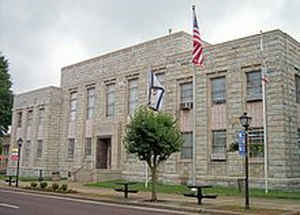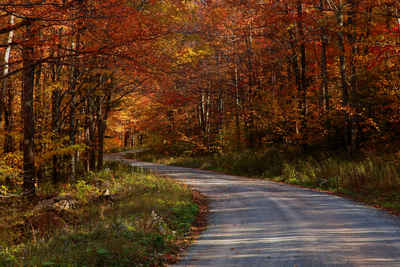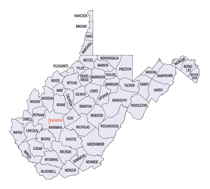West Virginia Counties
There are fifty-five counties in the state of West Virginia. Fifty of them existed at the time of the Wheeling Convention in 1861, before which West Virginia was part of the state of Virginia. The remaining five (Grant, Mineral, Lincoln, Summers and Mingo) were formed within the state after its admission to the United States on June 20, 1863. At that time, Berkeley County and Jefferson County, the two easternmost counties of West Virginia, refused to recognize their inclusion in the state. In March 1866, the US Congress passed a joint mandate assenting to their inclusion.Raleigh County, West Virginia
Raleigh County Education, Geography, and History

Raleigh County is a county located in the state of West Virginia. Based on the 2010 census, the population was 78,859. Its county seat is
Beckley. The county was founded in 1850 and is named for Sir Walter Raleigh.
Raleigh County is included in the Beckley, West Virginia Metropolitan Statistical Area.
Etymology - Origin of Raleigh County Name
For Sir Walter Raleigh, English adventurer and soldier
Demographics:
County QuickFacts: CensusBureau Quick Facts
Early History of Raleigh County, West Virginia
Raleigh County was created by an act of the Virginia General Assembly on January 23, 1850, from parts of Fayette County. It was named in honor of Sir Walter Raleigh (1552-1618), an English soldier, adventurer, and the favorite of Queen Elizabeth.
In 1584, Sir Walter Raleigh convinced the Queen to finance an expedition to the New World. He set sail from London in April 1584 with two ships. He was to explore the New World and find gold or other riches for the Queen. He reached the shore of North Carolina in July and remained there until September before returning to England. Although he did not find gold, he returned with a glowing description of the country. Happy to see his safe return, the Queen knighted Raleigh, named him Captain of the Queen's Guard, and appointed him to Parliament. The land was named Virginia, in the Queen's honor (unmarried, Queen Elizabeth was known as the "Virgin Queen"). Raleigh then convinced the Queen to send another fleet of ships to the continent to found a settlement and, by so doing, secure the lands from the St. Lawrence on the north to Florida on the south from the Spanish and the French. A total of 108 men made the voyage and established themselves on Roanoke Island, now North Carolina. Most of the "settlers" were actually speculators hoping to find gold and other riches and were not used to the hard work necessary to establish a permanent colony. When the supply ships returned later that year, most of the colonists, distressed that they had not found an easy way to get rich, demanded to be returned to England. Only 15 men volunteered to stay. In 1587, another fleet of ships brought more colonists to the Island, but when they arrived there was no trace of the 15 men who had stayed behind. It was assumed that they had been murdered by Indians. The colonists decided to stay and restart the colony only after the commander of the fleet assured them that he would return immediately with reinforcements. However, by the time the ships reached England a war had broken out between Spain and England and the ships were needed to defend the nation. A fleet of ships were finally sent to the colony in 1590, but when they arrived at the island, there was no trace of the colony. Sir Walter Raleigh's dream of an American colony had failed.
Raleigh later fell into disfavor with the Queen, primarily because he was found having a relationship with Elizabeth Throgmorton, one of the Queen's maids of honor. He was sent to prison for a short time and he later married Elizabeth Throgmorton. After the Queen died in 1603, King James stripped Raleigh of his titles and lands, and imprisoned him, his wife and his son in the Tower of London for 13 years. He was released in 1616 to allowed to search for gold in the New World. The expedition failed and he was beheaded in 1618 at the insistence of the Spanish for his role in the destruction of the Spanish colony, San Tomas. It is said that when he went to his execution he was elegantly dressed and spoke for nearly an hour to a very large crowd that had gathered to see the event.
John Peter Salley was the first Englishman to set foot in present Raleigh County. He explored the area in 1742. The next English visitor was probably Christopher Gist. He explored the lands south of the Ohio River on behalf of a land investment company (the Ohio Company) in 1750 and 1751. It is likely that he passed through the county on his return to Virginia. Between 1750 and 1830 the county was a favorite hunting site for fur traders who traveled throughout the county in search of beaver pelts.
William Richmond was the first English settler in the county. He arrived between 1807 and 1810. John Harper arrived in 1810 and Joseph Harper arrived the following year. By the spring of 1815, there were 63 families living in the present county.
Brigadier-General Alfred Beckley (1802-1888) was the most prominent citizen in the county for many years. He arrived in 1836 (then Fayette County) and served as the county's physician, preacher, and philanthropist. A graduate of West Point, he served in the military for 13 years before settling in the county. He later represented Raleigh County in the House of Delegates at Wheeling, and, at the onset of the Civil War, was commissioned a Brigadier-General of the Militia, under the command of General Henry A. Wise, in the Confederate Army. His command was disbanded in 1862 and he returned home to Beckley, which was occupied by the Union Army at that time. He surrendered himself to the Union officer in charge, and was held prisoner for several months before being released on parole. In his later years he was a leader in the state temperance movement.
Beckley, the county seat, was founded on General Alfred Beckley's land and was originally called Beckleyville. Chartered by the Virginia General Assembly in 1838, some historians claim that the town was named for General Alfred Beckley's father, John Beckley. He was the first Clerk of the Congress during the administrations of Presidents George Washington, John Adams and Thomas Jefferson and later served as the first Librarian of Congress. Others claim that the town was named for General Alfred Beckley. In either case, the town had a very slow start. The first business did not locate in the town until 1850 and prior to that time the local settlers sarcastically referred to Beckley's land as "Beckley's Paper Town." By 1860, the town's population had grow to only 160, with another 160 living in the vicinity. From 1881 to 1897, the town was called Beckleyville, Town of Beckley, and Raleigh Court House. The name Beckley finally won out around 1897. It was incorporated by the West Virginia
state legislature on April 26, 1927.
Geography: Land and Water
As reported by the Census Bureau, the county has a total area of 609 square miles (1,580 km2), of which 605 square miles (1,570 km2) is land and 4.0 square miles (10 km2) (0.7%) is water.
Neighboring Counties
Bordering counties are as follows:
- Northeast: Fayette County
- Northwest: Boone County; Kanawha County
- Southeast: Summers County; Mercer County
- Southwest: Wyoming County
Education







